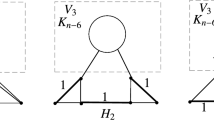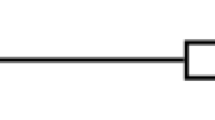Abstract
The main results of this paper establish relationships between the bandwidth of a graphG — which is the minimum over all layouts ofG in a line of the maximum distance between images of adjacent vertices ofG — and the ease of playing various pebble games onG. Three pebble games on graphs are considered: the well-known computational pebble game, the “progressive” (i.e., no recomputation allowed) version of the computational pebble game, both of which are played on directed acyclic graphs, and the quite different “breadth-first” pebble game, that is played on undirected graphs. We consider two costs of a play of a pebble game: the minimum number of pebbles needed to play the game on the graphG, and the maximumlifetime of any pebble in the game, i.e., the maximum number of moves that any pebble spends on the graph. The first set of results of the paper prove that the minimum lifetime cost of a play of either of the second two pebble games on a graphG is precisely the bandwidth ofG. The second set of results establish bounds on the pebble demand of all three pebble games in terms of the bandwidth of the graph being pebbled; for instance, the number of pebbles needed to pebble a graphG of bandwidthk is at most min (2k 2+k+1, 2k log2|G|); and, in addition, there are bandwidth-k graphs that require 3k−1 pebbles. The third set of results relate the difficulty of deciding the cost of playing a pebble game on a given input graphG to the bandwidth ofG; for instance, the Pebble Demand problem forn-vertex graphs of bandwidthf(n) is in the class NSPACE (f(n) log2 n); and the Optimal Lifetime Problem for either of the second two pebble games is NP-complete.
Zusammenfassung
Die Hauptergebnisse dieser Arbeit ergeben Beziehungen zwischen der „Bandwidth” eines GraphenG — die das Minimum ist, über alle Projektionen vonG auf eine Linie, von dem maximalen Abstand zwischen Bildern benachbarter Knoten vonG — und der Leichtigkeit, verschiedene „Pebble Games” aufG zu spielen. Es werden drei Pebble Games auf Graphen betrachtet: das wohlbekannte „computational” Pebble Game, die „progressive” (d. h. keine Wiederberechnung erlaubt) Version des computational Pebble Game, von denen beide auf directed acyclic Graphen gespielt werden, und das ziemlich verschiedene „breadth-first” Pebble Game, das auf undirected Graphen gespielt wird. Wir betrachten zwei verschiedene Kosten für das Pebble Game: die minimale Anzahl von Pebbles, die man braucht, um das Pebble Game auf einem GraphenG zu spielen, und die maximaleLebensdauer eines Pebble in einem Spiel, d. h. die maximale Anzahl von Zügen während denen ein Pebble auf dem Graphen verweilt. Die erste Gruppe von Hauptergebnissen in dieser Arbeit zeigt, daß die minimalen Lebensdauer-Kosten eines Spielverlaufs in einem der beiden letzten Pebble Games auf einem Graphen genau die Bandwidth vonG ist. Die zweite Gruppe von Ergebnissen stellt obere Schranken auf für die Anzahl von benötigten Pebbles in Abhängigkeit von der Bandwidth des betrachteten Graphen, z. B. um einen GraphenG mit Bandwidthk zu pebblen, braucht man höchstens min (2k 2+k+1, 2klog2|G|) Pebbles; ferner gibt es GraphenG von Bandwidthk für die man 3k−1 Pebbles braucht. Die dritte Gruppe von Ergebnissen setzt die Schwierigkeit, die Kosten eines Pebble Game auf einem gegebenen input-GraphenG festzustellen, in Beziehung zur Bandwidth vonG, z.B. das „Pebble Demand Problem” für Graphen mitn vertices von Bandwidthf(n) ist in der Klasse NSPACE (f(n)log2 n); und das „Optimal Lifetime Problem” ist für jedes der beiden letzten Pebble Games NP-vollständig.
Similar content being viewed by others
References
Aykuz, F. A., Tuku, S.: An automatic node-relabelling scheme for bandwidth minimization of stiffness matrices. Amer. Inst. of Aero. and Astro. J.6, 728–730 (1968).
Chen, K. Y.: Minimizing the bandwidth of sparse symmetric matrices. Computing11, 27–30 (1973).
Cook, S. A.: An observation on time-space tradeoffs. J. Comp. Syst. Sci.9, 308–316 (1974).
Garey, M. R., Graham, R. L., Johnson, D. S., Knuth, D. E.: Complexity results for bandwidth minimization. SIAM J. Appl. Math.34, 477–495 (1978).
Gilbert, J. R., Lengauer, T., Tarjan, R. E.: The pebbling problem is complete in polynomial space. SIAM J. Comput.9, 513–524 (1980).
Hopcroft, J. E., Paul, W., Valiant, L. G.: On time versus space. J. Assoc. Comput. Math.24, 332–337 (1977).
Kung, H. T., Stevenson, D.: A software technique for reducing the routing time on a parallel computer with a fixed interconnection network. In: High Speed Computer and Algorithm Optimization, pp. 423–433. New York: Academic Press 1977.
Lengauer, T.: Relationships between pebble games on directed and undirected graphs. Typescript, 1980.
Lingas, A.: AP-space complete problem related to a pebble game. Lecture Notes in Computer Science62, pp. 300–321. Berlin-Heidelberg-New York: Springer 1978.
Lipton, R. J., Eisenstat, S. C., DeMillo, R. A.: Space and time hierarchies for classes of control structures and data structures. J. ACM23, 720–732 (1976).
Meyer auf der Heide, F.: A comparison of two variations of a pebble game on graphs. Theor. Comp. Sci.13, 315–322 (1981).
Monien, B., Sudborough, I. H.: Bandwidth problems in graphs. Proc. 1980 Allerton Conf. on Communication, Control, and Computing1980, 650–659.
Monien, B., Sudborough, I. H.: Bandwidth constrained NP-complete problems. Proc. 1981 ACM Symp. on Theory of Computing, Milwaukee, Wisc., pp. 207–217.
Papadimitriou, Ch. H.: The NP-completeness of the bandwidth minimization problem. Computing16, 263–270 (1976).
Paterson, M. S., Hewitt, C. E.: Comparative schematology. Proc. Proj. MAC Conf. on Concurrent Systems and Parallel Computation, 1970, pp. 119–127.
Pippenger, N.: Pebbling. In: Proc. 5th IBM Symp. on Mathematical Foundations of Computer Science, 1980.
Rose, D. J.: A graph-theoretic study of the numerical solution of sparse positive definite systems of linear equations. In: Graph Theory and Computing (Read, R., ed.), pp. 183–217. New York: Academic Press 1972.
Rosenberg, A. L.: Data encodings and their costs. Acta Inform.9, 273–292 (1978).
Rosenberg, A. L., Snyder, L.: Bounds on the costs of data encodings. Math. Syst. Th.12, 9–39 (1978).
Saxe, J. B.: Dynamic-programming algorithms for recognizing small-bandwidth graphs in polynomial time. Carnegie-Mellon Tech. Rpt. CMU-CS-80-102, 1980.
Sethi, R.: Complete register allocation problems. SIAM J. Comput.4, 226–248 (1975)
Sudborough, I. H.: Pebbling and bandwidth. In: Fundamentals of Computation Theory (Lecture Notes in Computer Science, Vol. 117), pp. 373–383. Berlin-Heidelberg-New York: Springer 1981.
Author information
Authors and Affiliations
Additional information
Aportion of this author's research was done while visiting the Department of Computer Science, University of Toronto, Toronto, Canada; a portion was done while with the Mathematical Sciences Department, IBM Research Center, Yorktown Heights, N. Y.; and a portion was supported by NSF Grant MCS-8116522.
A portion of this author's research was supported by NSF grant MCS-79-08919.
Rights and permissions
About this article
Cite this article
Rosenberg, A.L., Sudborough, I.H. Bandwidth and pebbling. Computing 31, 115–139 (1983). https://doi.org/10.1007/BF02259908
Received:
Revised:
Issue Date:
DOI: https://doi.org/10.1007/BF02259908




